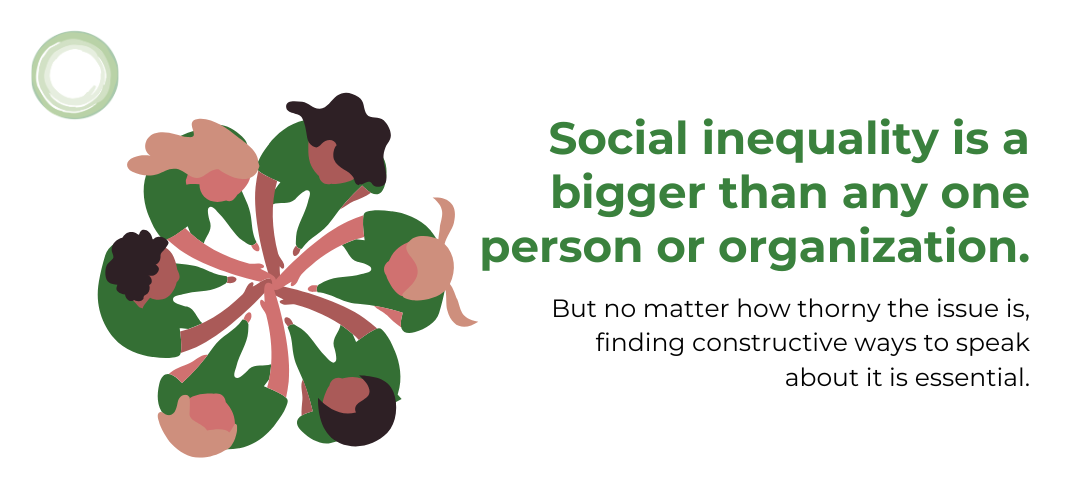Why Leaders Avoid Talking About Diversity
While study after study demonstrates diversity drives major business benefits, the truth is most of us would rather not talk about the issues that force us to have diversity strategies in the first place.
Or at least not talk directly with those we want to influence.
Instead we talk “amongst ourselves,” with those who can sympathize with our situation, rather than being brave enough to have the conversations that matter most.
Asking our colleagues and employees about whether and how they experience gender (or race) bias getting in their way at work strikes many of us as a conversation ten times more loaded than it’s worth.
Even senior leaders fear they’re walking into territory strewn with red flags from HR. The anxiety that causes you to hold back costs your business. It harms your relationship with employees who wonder if there are better opportunities elsewhere — and it undermines your leadership.
Want to lead with greater inclusivity and emotional intelligence? Take our free Enneagram leadership quiz to understand how your type may influence the way you lead.
As a CEO advisor, clients tell me what holds them back from talking to their teams about diversity is the desire to have the answers before they risk the conversation. But you don’t have all the answers!
Leaders often hesitate to initiate these conversations without confidence — here’s how to build executive presence and lead through discomfort.
Social inequality is a bigger than any one person or organization. But no matter how thorny the issue is, finding constructive ways to speak about it is essential.

Why Asking Questions Creates Inclusion
Here’s how you might go about having the conversation you’ve been avoiding: by asking the very questions you’ve been afraid to ask! Yes, it’s that simple.
Do you know how the women or minorities around you feel treated at work? Have you asked?
Harvard researchers have shown people don’t ask enough questions, never mind the right kind. They point out that most of us “don’t grasp that asking a lot of questions unlocks learning and improves interpersonal bonding.” That second part is especially significant when tackling diversity.
Whether you’re male or female, white or not, asking questions doesn’t mean you take the blame. It means you care and that you’re interested in someone else’s experience other than your own.
On the receiving end, being heard can be an antidote to being misunderstood, overlooked and undervalued … which may be how many women and minorities feel they are treated today. Not only that, asking questions gives people a chance to share what they might keep to themselves: practical changes to make and why.
Looking to bring these conversations into your team? Our inclusive leadership training helps leaders foster meaningful change — not just strategy.
How to Ask Brave, Effective Diversity Questions
If we apply what the Harvard research tells us about the power of questions, the diversity conversation would look like this:
- Start with the context regarding your question. I read a blog this morning about diversity … or There was an article in the paper about gender issues at work … or I know we’re doing more to communicate our diversity strategies … or I was speaking with my client about an issue they have … or I noticed there were no other women in that meeting yesterday …
- Move to an open question. Those framed to avoid simple yes or no responses. Make it simple, sincere and direct, such as: How do you think we’re doing at creating a diverse and inclusive workplace? In your experience, what makes this a good or bad place to work for women? (You should be asking these questions of everyone — men and women alike.)
- Be prepared for potential resistance. No doubt some people won’t see this line of question coming! Some won’t be sure what they think (not without some reflection.) Others will be reluctant to be candid. Have a “holding statement” ready, such as: If anything occurs to you down the road, I’m interested to know what you think about this. This statement alone can prove more of a positive signal than you realize.
- Never underestimate the power of being listened to. According to the research, the follow-on question is the most powerful of all. You learn more. And you’re showing a form of listening which deepens trusts. So, when the person you’re talking to does have an opinion, ask questions like: Can you say more about that? Could you give me an example of what you mean? What might we/I do differently? Deep listening is a cornerstone of emotionally intelligent leadership — and vital to creating inclusion.

Whenever you’re talking with someone about their career — or one of the many occasions where you could find out how work is going for the people around you — that’s the time to start a “diversity conversation.”
And as for responding to what your colleagues have to say? Just tell the truth: I don’t have all the answers, but I’m certain that understanding the situation more clearly can only help. Again, it’s that simple. Inclusive leadership means getting honest feedback from those around you — here’s how to create that culture.
The Hard Truth: Change Requires Conversation
We’ve all seen the data and know some of the stats. Here’s just one: women would have to work an additional twelve years to close the pay gap that exists with male counterparts. And while many workplaces have explicit strategies that attempt to tackle that, true organizational change stems from individual acts of leadership.
The conversation you’re avoiding is the very one needed to address the deep, systemic issues of inequality in our society and in the workplace.
Want support in creating leadership that is more diverse and inclusive in approach and thought? We are working with clients to create powerful affinity groups to support women and minority advancement, in addition to working with senior leadership to foster greater inclusivity. Explore our bespoke programs for DEI and leadership development to start the shift today.
Contact us for more information on how we can help you create an empowered and diverse workplace.


